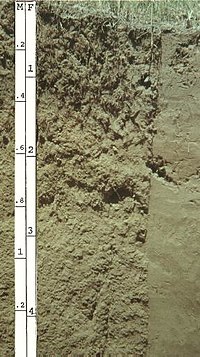
Back Entisòl Catalan Entisol German Entisol Spanish Entiszol Hungarian Entisol ID Entisol Italian Entisol Malay Entisol Dutch Entissolo Portuguese Ентісоль Ukrainian
| Entisol | |
|---|---|
 Entisol profile showing little or no evidence of pedogenic horizon development | |
| Used in | USDA soil taxonomy |
Entisols are soils, as defined under USDA soil taxonomy, that do not show any profile development other than an A-horizon (or “A” horizon). Entisols have no diagnostic horizons, and are unaltered from their parent material, which could be unconsolidated sediment, or rock. Entisols are the most common soils, occupying about 16% of the global ice-free land area.
Because of the diversity of their properties, suborders of entisols form individual Reference Soil Groups in the World Reference Base for Soil Resources (WRB): psamments correlate with arenosols, and fluvents with fluvisols. Many orthents belong to regosols or leptosols. Most wassents and aquic subgroups of other suborders belong to the gleysols.[1]
In Australia, most entisols are known as rudosols or tenosols.
- ^ IUSS Working Group WRB (2015). "World Reference Base for Soil Resources 2014, Update 2015" (PDF). World Soil Resources Reports 106, FAO, Rome.